Abstract
The scaled charge trapping (CT) type silicon on insulator (SOI) FinFET flash memories with different blocking layer materials of Al2O3 and SiO2 have successfully been fabricated, and their electrical characteristics including short-channel effect (SCE) immunity, threshold voltage (Vt) variability, and the memory characteristics have been comparatively investigated. It was experimentally found that the better SCE immunity and a larger memory window are obtained by introducing a high-k Al2O3 blocking layer instead of a SiO2 blocking layer. It was also confirmed that the variability of Vt before and after one program/erase (P/E) cycle is almost independent of the blocking layer materials.
1. Introduction
Device scaling is very effective for the fabrication of high-density and low-cost flash memories. However, further scaling of conventional bulk planar MOSFET type flash memories becomes very difficult because of the increased short-channel effect (SCE) and the lowered source-drain (SD) breakdown voltage (BVDS) with scaling down device size [1,2,3]. Especially, in the NOR-type flash memory, further scaling of device size faces the theoretical limit of BVDS which corresponds to the silicon (Si) and silicon dioxide (SiO2) conduction band difference (3.2 eV). This indicates that channel hot electron (CHE) programming cannot be guaranteed in the scaled NOR-type flash memories with gate length (Lg) smaller than 100 nm [2,3]. On the other hand, three-dimensional (3D) channel devices, such as fin-type double-gate (DG) MOSFET (FinFET) and fin-channel tri-gate (TG) device, provide excellent SCE immunity owing to the strong controllability of channel potential by the multiple gates [4,5,6,7,8,9,10,11,12,13]. Moreover, threshold voltage (Vt) variability in the FinFETs and TG devices is much smaller than that in the conventional bulk planar MOSFETs because the random dopant fluctuation (RDF) induced Vt variation is negligible in the FinFETs and TG devices due to the undoped fin-channels [14,15,16,17,18,19,20,21,22]. Therefore, the scaled charge trapping (CT) type fin-channel flash memories using silicon on insulator (SOI)-based fin-channels and body-tied bulk Si fin-channels have actively been developed [23,24,25,26,27,28,29,30,31,32]. However, a high-k blocking layer is strongly required in the ultimately scaled CT type flash memory fabrication to overcome the gate coupling area decrease with scaling down the device size [33]. As a high-k blocking layer, an Al2O3 layer has been used in the planar MOSFET type and body-tied bulk FinFET type flash memories [28,34]. By introducing such a high-k blocking layer, the gate injection current is effectively suppressed during program/erase (P/E) operations because the electric field across the blocking layer is proportionally reduced owing to its high dielectric constant, which is useful for the enlarging of memory window. However, the blocking layer material effect on the electrical characteristics of SOI-FinFET flash memories has not been studied sufficiently. Very recently, we have demonstrated floating gate (FG) type split-gate fin-channel flash memories with a highly suppressed over erase, and experimentally confirmed that nanosize triangular cross-section tunnel areas are useful for the fabrication of the low operating voltage flash memories owing to the enhanced local electric field at the tips of triangular tunnel areas [35,36,37,38]. We have also fabricated and investigated FG type crystalline and polycrystalline Si fin-channel flash memories with DG and TG structures, and confirmed that TG structured flash memory shows the better SCE immunity and a larger memory window than the DG structured one owing to the additional top gate and recessed buried oxide (BOX) region [39,40,41]. Moreover, we have also investigated the gate material effect on the electrical characteristics of the CT type SOI-FinFET flash memories by introducing different gate materials of physical vapor deposited (PVD) titanium nitride (TiN) and n+-poly-Si [42]. It was experimentally found that a larger memory window is obtained in the PVD-TiN metal gate flash memories than the n+-poly-Si gate ones owing to the higher work function of PVD-TiN metal gate, which is efficient to suppress electron back tunneling during erase operation [28,34].
As a further study, in this work, we fabricate CT type SOI-FinFET flash memories with different blocking layer materials of atomic layer deposited (ALD) Al2O3 and chemical vapor deposited (CVD) SiO2, and comparatively investigate their electrical characteristics including SCE immunity, Vt variability and memory characteristics [43].
2. Device Fabrication
In order to investigate the blocking layer material effect on the electrical characteristics and memory properties of the CT type SOI-FinFET flash memories, we fabricated MANOS (PVD-TiN Metal-Al2O3-Nitride-Oxide-Silicon) type and MONOS (PVD-TiN Metal-Oxide-Nitride-Oxide-Silicon) type TG structured SOI-FinFET flash memories. Figure 1 shows the schematic three-dimensional (3D) device structure for the CT type SOI-FinFET flash memory. Except for the deposition of blocking layer materials, the same process was used in the fabrication for both types of devices. To fabricate an ideal rectangular cross-section Si-fin-channel by using the orientation-dependent wet etching, we used lightly doped p-type (110)-oriented SOI wafers as the starting material [7,8]. The initial thicknesses of the top silicon and BOX layers were 70 and 145 nm, respectively.
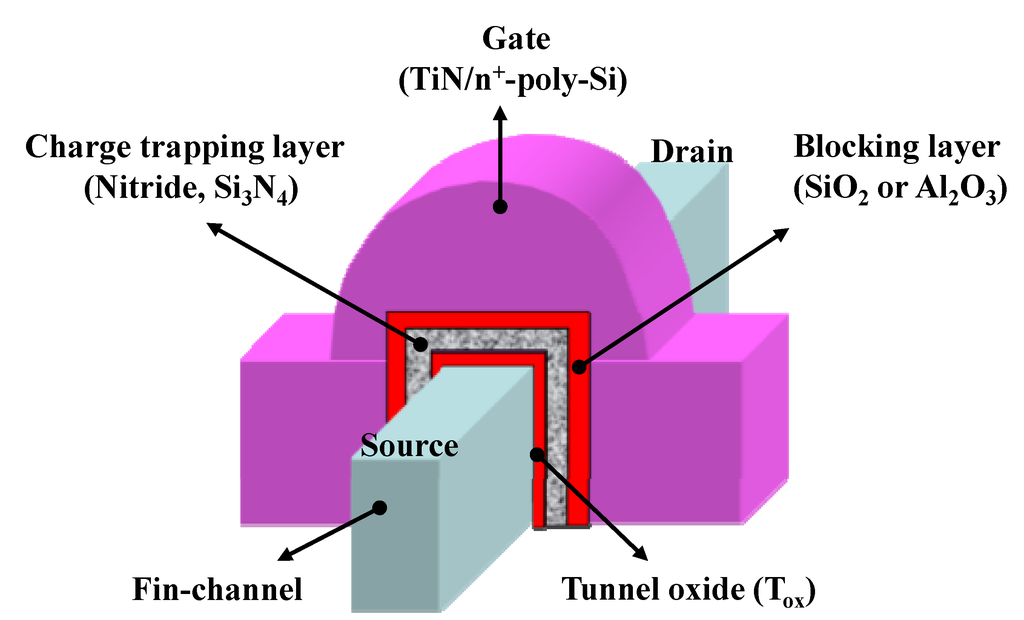
Figure 1.
Schematic three-dimensional (3D) device structure for the CT type SOI-FinFET flash memory with different blocking layer materials of Al2O3 and SiO2.
The schematic device fabrication process flow for the CT type SOI-FinFET flash memory is shown in Figure 2. First, the lightly doped p-type (110)-SOI wafers were thermally oxidized to form a 30-nm-thick SiO2 layer as shown in Figure 2a, and fin-patterns were delineated in parallel to the <112> direction by using electron-beam (EB) lithography as shown in Figure 2b. The trimming of EB-resist was performed using oxygen plasma to reduce the fin width. The fin-patterns were then transferred to the SiO2 layer on the (110)-SOI wafers by reactive ion etching (RIE). After removing the EB-resist, further narrowing of the width of SiO2 hard-mask was carried out with dilute hydrofluoric acid (DHF) solution. By using these techniques, the width of SiO2 hard-mask was controlled to around 20 nm.

Figure 2.
Schematic device fabrication process flow for the CT type SOI-FinFET flash memory. (a) Thermal oxidation; (b) fin-pattern formation by electron-beam (EB) lithography; (c) fin-channel formation by the orientation-dependent wet etching; (d) SiO2 hard-mask removing by RIE; (e) tunnel oxide (Tox) formation by thermal oxidation; (f) nitride (Si3N4) layer deposition by LPCVD; (g) blocking layer (Al2O3 for MANOS and SiO2 for MONOS) deposition; (h) PVD-TiN deposition; (i) n+-poly-Si deposition.
Through the SiO2 hard-masks, fin-channels were fabricated by the orientation-dependent wet etching with a 2.38% tetramethylammonium hydroxide (TMAH) solution at 50 °C for 30 s, as shown in Figure 2c. Since the sidewalls of the fin-channels have a (111)-oriented plane with an extremely low etching rate in TMAH compared with other planes, very narrow and straight fin-channels can easily be fabricated. It was experimentally confirmed that the etching rates for (100)-, (110)-, and (111)-oriented Si wafers were 214, 359, and 9 nm/min, respectively [44]. This indicates that the (111) plane is successfully retained in the etching process. To fabricate TG structure, the SiO2 hard-mask layer was removed by RIE as show in Figure 2d, which results in a slight reduction of fin-height. A recessed BOX region was also formed in this RIE process, which is useful for the suppression of SCE [39,40,41].
After the fin-channel formation, a 4.3-nm-thick tunnel oxide (Tox) layer was formed by thermal oxidation at 850 °C as shown in Figure 2e, followed by the deposition of a 10-nm-thick Si3N4 layer as the charge trapping layer by low-pressure chemical vapor deposition (LPCVD) at 790 °C as shown in Figure 2f. As the blocking layer, a 9-nm-thick tetraethylorthosilicate (TEOS)-SiO2 layer was deposited for MONOS type devices by plasma CVD at 350 °C, and a 10-nm-thick Al2O3 layer was deposited for MANOS type device by atomic layer deposition (ALD) at 300 °C as shown in Figure 2g. In the ALD deposition, we used trimetylaluminum (TMA) and water gas at pressure of 14 hPa. As the same gate material, a combination of a 20-nm-thick PVD-TiN layer and a 100-nm-thick n+-poly-Si layer, was deposited on all wafers as shown in Figure 2h,i. The gate electrodes were also patterned by EB lithography and fabricated by using combination of inductively coupled plasma (ICP) RIE for n+-poly-Si and wet etching for PVD-TiN. In the PVD-TiN wet etching, we used an ammonium hydroxide (NH4OH):hydrogen peroxide (H2O2):deionized water (H2O) = 1:2:5 (APM) solution at 60 °C, which provides a high etching selectivity of PVD-TiN to SiO2 [45,46].
After etching the top ONA and ONO layers on the fin extension and SD electrode regions by RIE, arsenic (As) ion implantation (I/I) was performed for SD-extension with a dose (D) of 4 × 1014 cm−2 and a tilting angle (θ) of 60° at a fixed implant energy of 5 keV [47]. Then, an 80-nm-thick gate sidewall spacer was formed by deposition of TEOS-SiO2 and RIE. For the SD-region I/I, phosphorus ion (P+) was used with D = 1.5 × 1015 cm−2 and θ = 7°, which was followed by the deposition of a 100-nm-thick TEOS-SiO2 layer on all wafers. To activate the implanted impurities, rapid thermal annealing (RTA) was performed at 830 °C for 2 s. Finally, contact holes and aluminum electrodes were formed, and all wafers were sintered in forming gas ambient at 450 °C for 30 min.
3. Results and Discussion
The scanning electron microscopy (SEM) images of the fabricated MANOS type SOI-FinFET flash memory after fin-channel formation and gate formation are shown in Figure 3a,b, respectively. Note that a straight 22-nm-thick Si-fin channel is successfully fabricated thanks to the orientation-dependent wet etching. Moreover, a scaled 26-nm gate is also clearly confirmed.
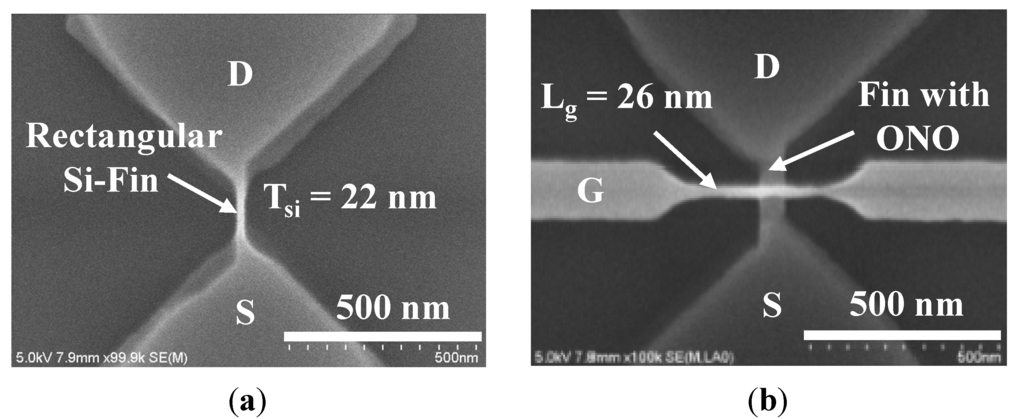
Figure 3.
SEM images of the fabricated CT type SOI-FinFET flash memory (a) after fin-channel formation by the orientation-dependent wet etching and (b) after gate formation.
Figure 4a,b show the cross-sectional scanning transmission electron microscopy (STEM) images of the fabricated MANOS and MONOS type SOI-FinFET flash memories, respectively. Note that ultrathin and ideal rectangular cross-sectional Si fin-channels are fabricated uniformly. It should be mentioned that the fin-width and fin-height were slightly narrowed and lowered during wafer cleaning and tunnel oxide formation. Moreover, it is clearly confirmed that a uniform tunnel oxide layer is formed on top and sidewalls of the fin-channels without a thick SiO2 hard-mask on top of Si fin-channel. This indicates that TG structure is fabricated successfully. Furthermore, it can be seen from STEM images that the charge trapping ONA and ONO layers are not only formed around the top and sidewalls of the fin-channels but also extended to the recessed BOX region. Such a gate all around (GAA) like structure is useful to the suppression of SCE as mentioned before. The observed a thin SiO2 blocking layer (<9 nm) in Figure 4b probably depends on the pick-up position of STEM sample owing to the poor uniformity of TEOS-SiO2 layer thickness on a wafer although a 9-nm-thick TEOS-SiO2 layer was confirmed on a dummy wafer as mentioned before.
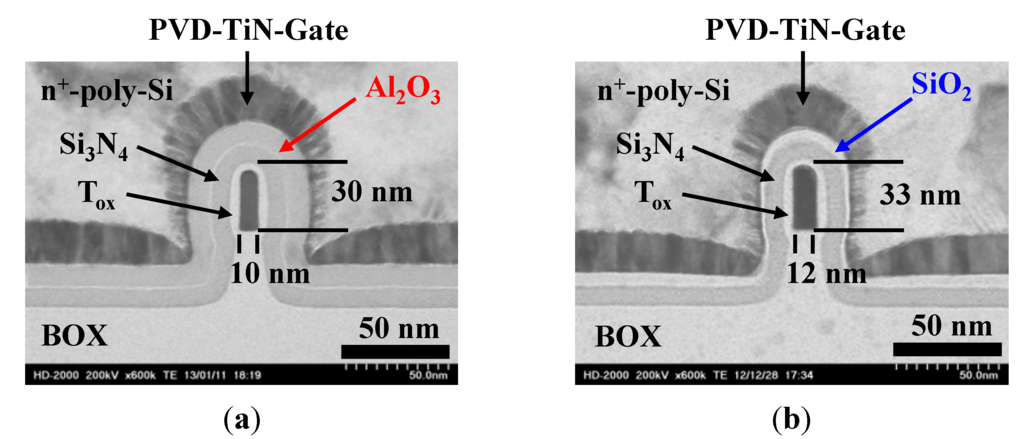
Figure 4.
Cross-sectional STEM images of the fabricated (a) MANOS type SOI-FinFET flash memory with an Al2O3 blocking layer; and (b) MONOS type SOI-FinFET flash memory with a SiO2 blocking layer.
At first, we evaluated the Vt variability and SCE immunity for the fabricated MANOS and MONOS type SOI-FinFET flash memories with different gate length (Lg) values from 26 to 103 nm. Figure 5a,b show the measured initial Id-Vg characteristics of the fabricated MANOS type flash memories with different Lg values of 26 and 38 nm, respectively. In this measurement, we used 40 cell transistors for each type to investigate statistical Vt variations. Note that an excellent S-slope of 105-mV/decade is obtained even Lg is scaled down to 26 nm due to the GAA like structure. However, the uniformity of Id-Vg curve is slightly deteriorated with scaling down Lg from 38 to 26 nm.
To evaluate Vt variations quantitatively, we measured the initial Vt values at a constant drain current of Id = 1 μA for all devices with different Lg values from 26 to 103 nm. Figure 6 shows the measured standard deviations of Vt (σVt) and S-slope (σS) as a function of Lg for the fabricated MANOS and MONOS type SOI-FinFET flash memories. It is clear that almost the same σVt and σS are obtained for both types of devices although they increase slightly with scaling down Lg. This result indicates that the variations of Vt and S-slope are almost independent of the blocking layer materials. The measured average Vt (<Vt>) and S-slope (<S>) values are summarized as a function of Lg as shown in Figure 7. Note that the smaller Vt roll-off and the better S-slope are obtained in the MANOS devices than the MONOS ones at whole range of Lg due to the high-k effect of Al2O3 in MANOS type devices.
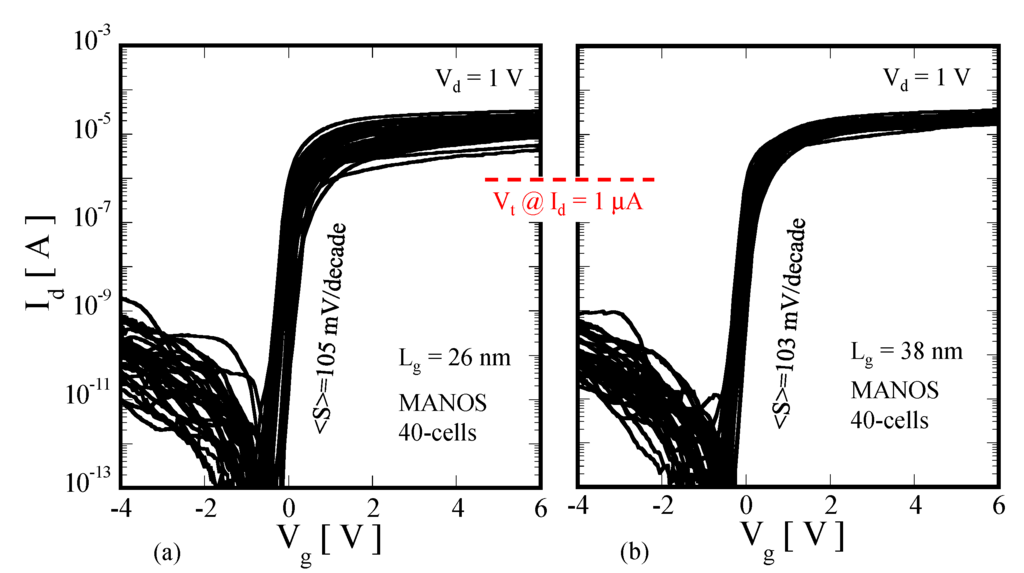
Figure 5.
Initial Id-Vg characteristics of the fabricated MANOS type SOI-FinFET flash memories with different Lg values of (a) Lg = 26 nm and (b) Lg = 38 nm.
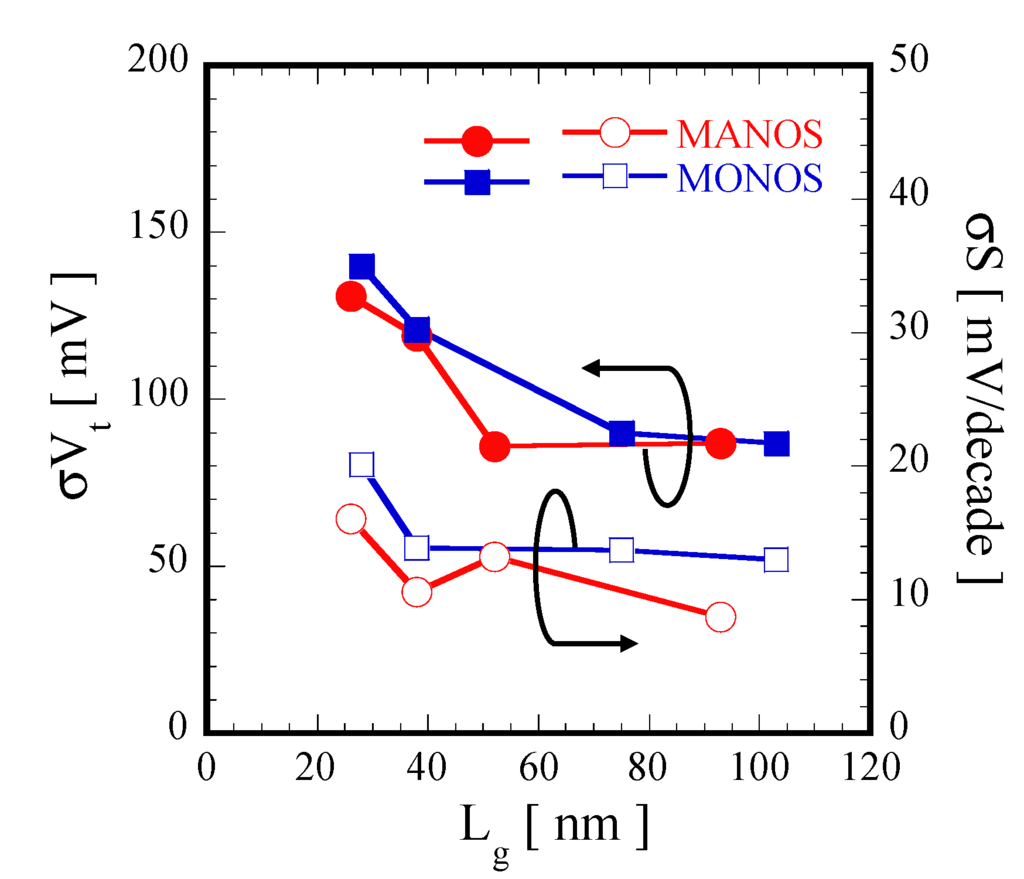
Figure 6.
σVt and σS as a function of Lg for the fabricated MANOS and MONOS type SOI-FinFET flash memories.
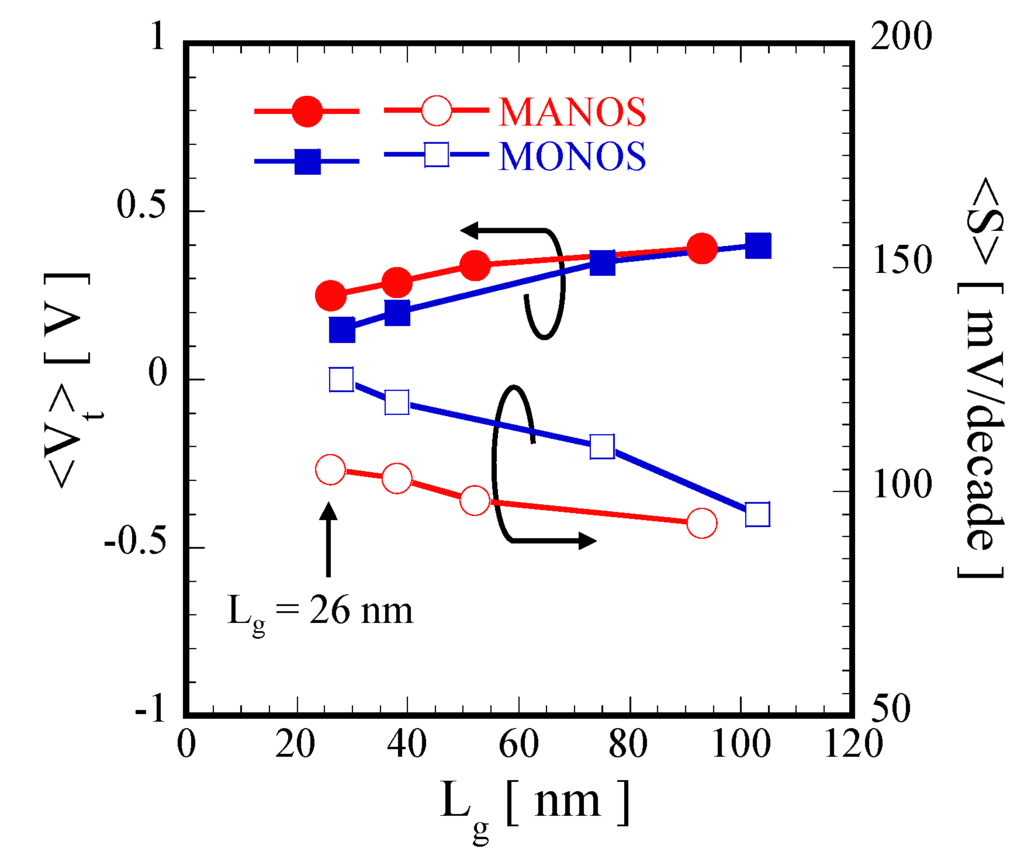
Figure 7.
Average Vt (<Vt>) and S-slope (<S>) values as a function of Lg for the fabricated MANOS and MONOS type SOI-FinFET flash memories.
Before evaluation of memory characteristics, gate breakdown voltage was measured for the fabricated MANOS and MONOS type SOI-FinFET flash memory cell transistors. It was found that the gate breakdown voltage is around 17 V. According to this experimental result, P/E bias conditions were determined as Vg = 16 V, pulse-time (t) = 50 μs for programming, Vg = −16 V, t = 20 ms for erasing. In order to evaluate the dependence of the memory characteristics on the blocking layer materials, including Vt variability and memory window, the Id-Vg characteristics of the fabricated MANOS and MONOS type devices with different Lg values were systematically investigated after one P/E cycle. Figure 8a,b show the measured Id-Vg characteristics of the fabricated MANOS type flash memory cell transistors with different Lg values of 26 and 38 nm after one P/E cycle, respectively. In this measurement, we used 40 cell transistors for each type. It is clear that a larger memory window is reasonably obtained in the long channel devices as compared to the short channel devices. A similar behavior was also observed in the MONOS type devices.
To compare the Vt variations between MANOS and MONOS type devices, Vt values for all fabricated devices were also evaluated at a constant drain current of Id = 1 μA. As an example, Figure 9 shows the measured cumulative probability of Vt and σVt values for the MANOS and MONOS type devices with the same Lg of 38 nm after one P/E cycle. Note that a larger memory window is obtained in the MANOS type devices than the MONOS type ones due to the high-k effect of Al2O3 blocking layer in MANOS type devices. However, it is clear that σVt values for both devices are almost the same although slightly smaller σVt values are observed in the MONOS type device than MANOS type one. Such comparison was also carried out for all fabricated MANOS and MONOS type devices with different Lg values, and it was confirmed that actually a larger memory window is obtained in the MANOS type devices than the MONOS type ones at whole range of Lg as shown in Figure 10. The deep erase in MANOS type devices should be resulted from the high-k effect of an Al2O3 (k ~ 9) blocking layer, which is efficient to enhance the electric field across the tunnel oxide and to reduce the electric field across the layer its self. Therefore, the electron back tunneling is effectively suppressed during erase operation which contributes to the deep erase in MANOS type devices [28,34].
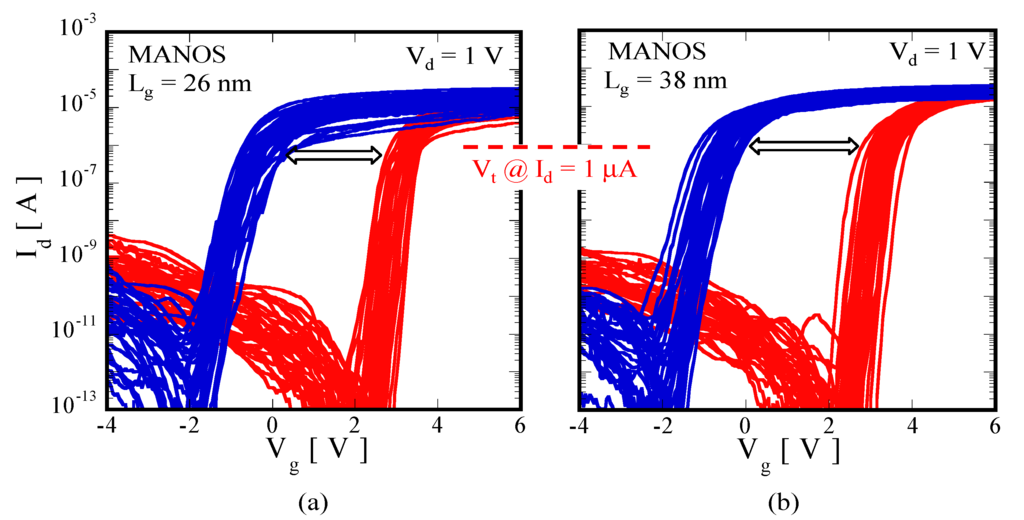
Figure 8.
Id-Vg characteristics of the fabricated MANOS type SOI-FinFET flash memory cell transistors (40 cells) with different Lg values of (a) Lg = 26 nm and (b) Lg = 38 nm. P/E conditions: Vg = 16 V, t = 50 μs for program, and Vg = −16 V, t = 20 ms for erase.
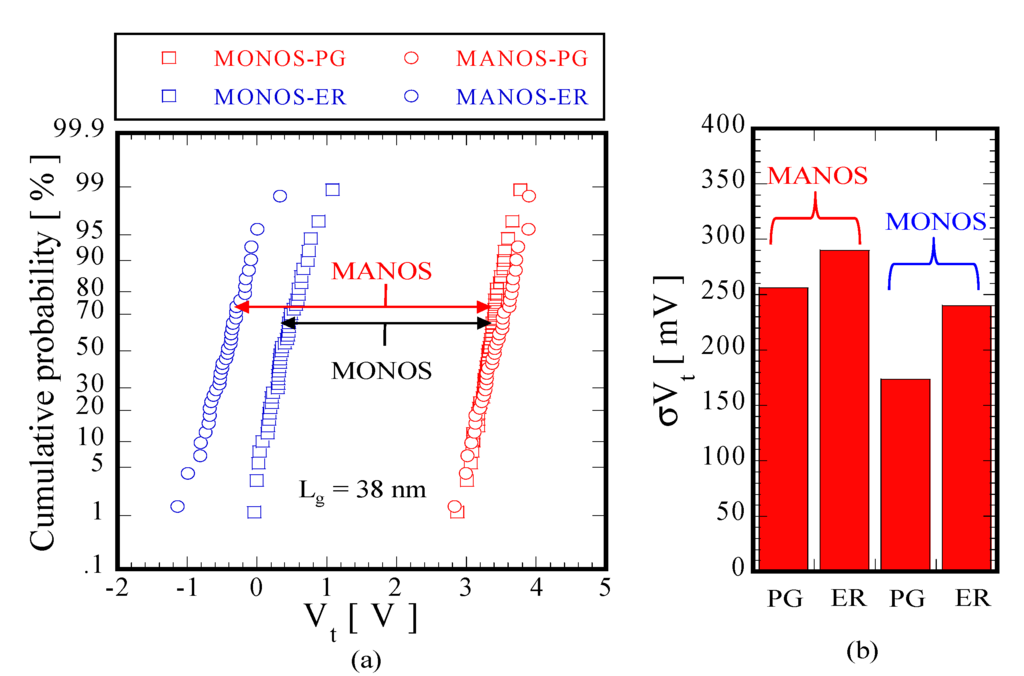
Figure 9.
(a) Cumulative probability of Vt and (b) σVt of the fabricated MANOS and MONOS type SOI-FinFET flash memories with the same Lg of 38 nm after one P/E cycle. P/E conditions: Vg = 16 V, t = 50 μs for program, and Vg = −16 V, t = 20 ms for erase.
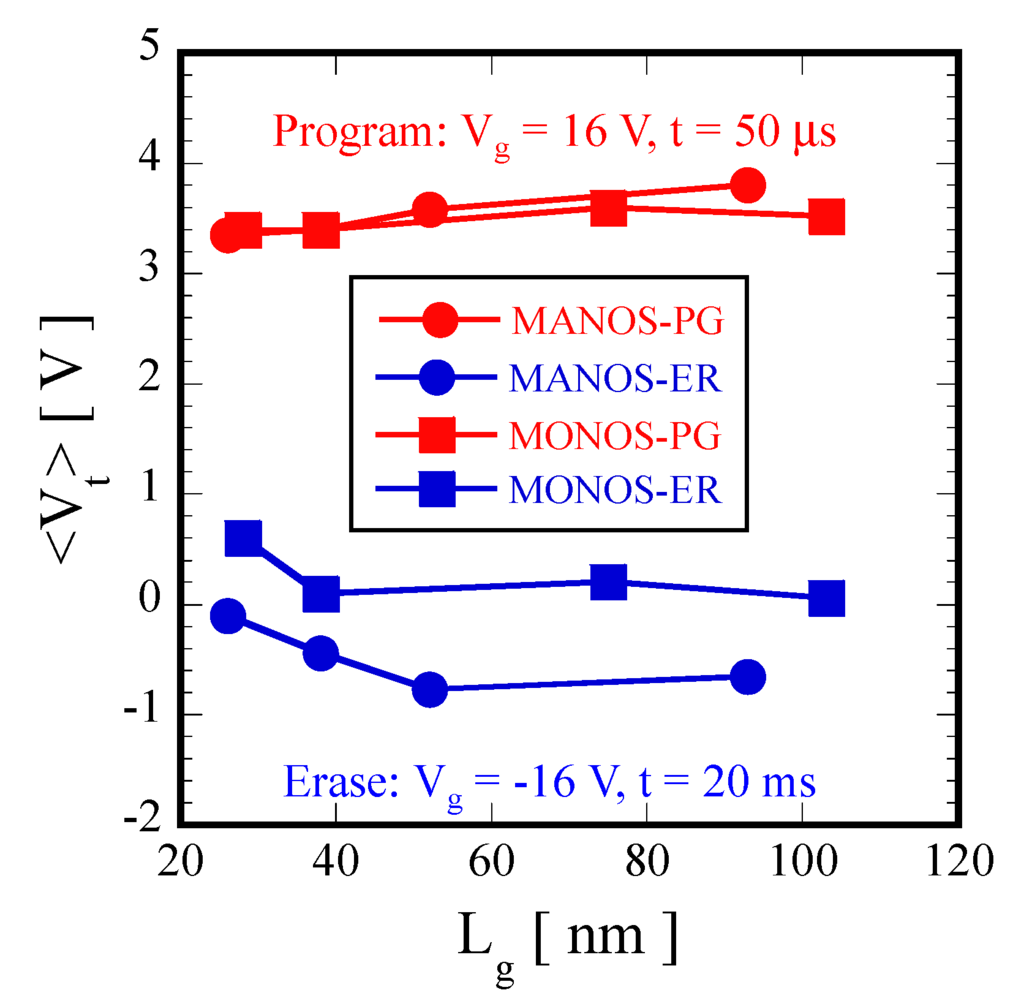
Figure 10.
Average Vt (<Vt>) values as a function of Lg for the fabricated MANOS and MONOS type SOI-FinFET flash memory cell transistors after one P/E cycle. P/E conditions: Vg = 16 V, t = 50 μs for program, and Vg = −16 V, t = 20 ms for erase.
Figure 11a shows the measured P/E characteristics of the fabricated MANOS type device with Lg of 93 nm at different |Vg| values, and the program-time dependence of the Id-Vg characteristics at Vg of 14 V is shown in Figure 11b. It is clear that a large memory window of 5.6 V is obtained keeping an excellent S-slope of 100-mV/decade due to the GAA like structure. Figure 12a,b show the measured endurance characteristics of the fabricated MANOS and MONOS type devices, respectively. Note that these two kinds of device can operate over 100 k cycles although somewhat remarkable degradation is observed in the MONOS type device after 10 k cycles probably due to the insufficient uniformity of CVD-SiO2 blocking layer. Moreover, the better data retention is obtained in the MANOS type device than MONOS type one due to the uniform ALD-Al2O3 blocking layer as shown in Figure 13.
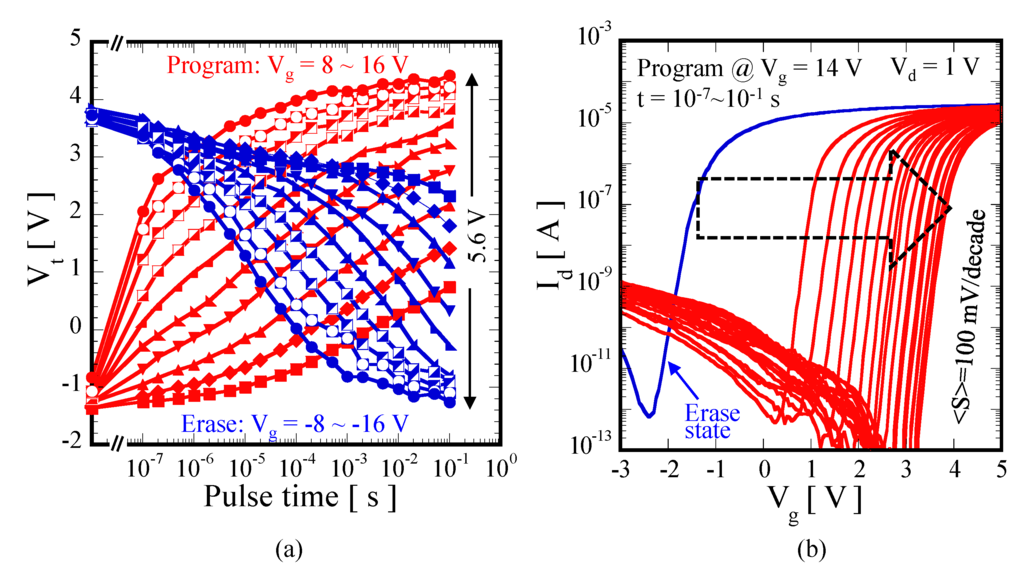
Figure 11.
(a) P/E characteristics and (b) program-time dependence of the Id-Vg characteristics of the fabricated MANOS type SOI-FinFET flash memory with Lg = 93 nm.
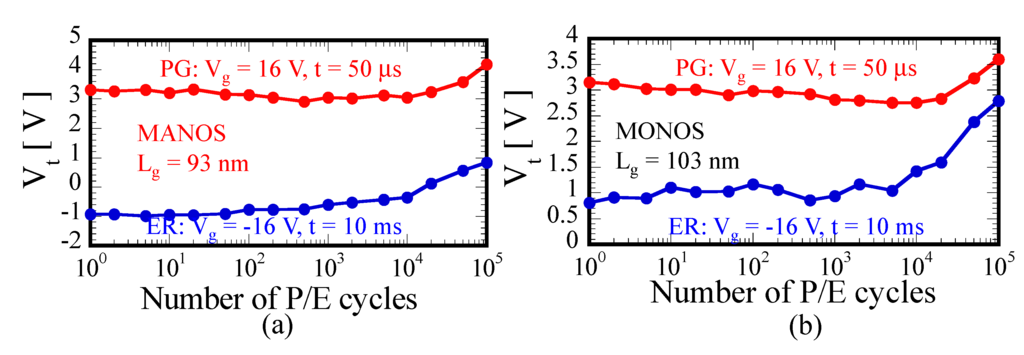
Figure 12.
Endurance characteristics of the fabricated (a) MANOS type SOI-FinFET flash memory with Lg = 93 nm; and (b) MONOS type SOI-FinFET flash memory with Lg = 103 nm.
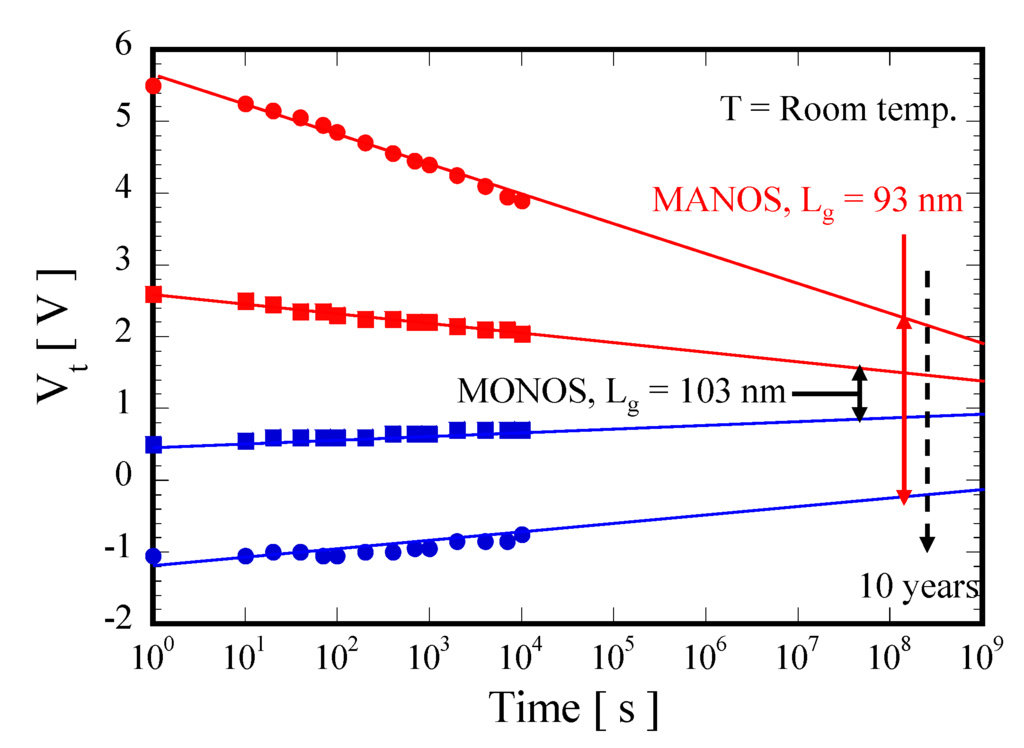
Figure 13.
Retention characteristics of the fabricated MANOS type SOI-FinFET flash memory with Lg = 93 nm and MONOS type SOI-FinFET flash memory with Lg = 103 nm at room temperature.
4. Conclusions
We have comparatively investigated the electrical characteristics and memory properties of the fabricated charge trapping type SOI-FinFET flash memories with different blocking layer materials of Al2O3 and SiO2. It was experimentally found that introducing a high-k Al2O3 blocking layer instead of a SiO2 one is very efficient for the enlarging of memory window owing to the high-k effect of Al2O3. It was also confirmed that Vt variability before and after one P/E cycle is almost independent of blocking layer materials.
Acknowledgments
This work was supported in part by the Nanotechnology Project of NEDO, Japan. The authors would like to thank Num Nguyen and Takeshi Inoshita of National Institute for Materials Science (NIMS) for fruitful discussions.
Conflicts of Interest
The authors declare no conflict of interest.
References
- Xuan, P.; She, M.; Harteneck, B.; Liddle, A.; Bokor, J.; King, T.-J. FinFET SONOS Flash Memory for Embedded Applications. In Proceedings of the IEEE International Electron Devices Meeting, Washington, DC, USA, 8–10 December 2003; pp. 609–612.
- Kim, T.-Y.; Cho, E.S.; Cho, H.J.; Sung, S.-K.; Lee, C.-H.; Choi, B.Y.; Cho, B.K.; Park, D.G. 256 Mb FinFET NOR Flash Memory for sub-70 nm Technology Breakthrough. In Proceedings of the International Silicon Nanoelectronics Workshop, Kyoto, Japan, 12–13 June 2005; pp. 98–99.
- Sim, S.-P.; Kim, K.S.; Lee, H.K.; Han, J.I.; Kwon, W.H.; Han, J.H.; Lee, B.Y.; Jung, C.; Park, J.H.; Kim, D.J.; et al. Fully 3-Dimensional NOR Flash Cell with Recessed Channel and Cylindrical Floating Gate-A Scaling Direction for 65nm and Beyond. In Proceedings of the Symposium on VLSI Technology, Honolulu, HI, USA, 13–15 June 2006; pp. 22–23.
- Hisamoto, D.; Lee, W.-C.; Kedzierski, J.; Takeuchi, H.; Asano, K.; Kuo, C.; Anderson, E.; King, T.-J.; Boker, J.; Hu, C. FinFET—A self-aligned double-gate MOSFET scalable to 20 nm. IEEE Trans. Electron Devices 2000, 47, 2320–2325. [Google Scholar] [CrossRef]
- Choi, Y.-K.; Lindert, N.; Xuan, P.; Tang, S.; Ha, D.; Anderson, E.; King, T.-J.; Bokor, J.; Hu, C. Sub-20 nm CMOS FinFET Technologies. In Proceedings of the IEEE International Electron Devices Meeting, Washington, DC, USA, 2–5 December 2001; pp. 421–424.
- Yu, B.; Chang, L.; Ahmed, S.; Wang, H.; Bell, S.; Yang, C.-Y.; Tabery, C.; Ho, C.; Xiang, Q.; King, T.-J.; et al. FinFET Scaling to 10 nm Gate Length. In Proceedings of the IEEE International Electron Devices Meeting, San Fransico, CA, USA, 8–11 December 2002; pp. 251–254.
- Liu, Y.X.; Ishii, K.; Tsutsumi, T.; Masahara, M.; Takashima, H.; Suzuki, E. Ideal Rectangular Cross-Section Si-Fin Channel Double-Gate MOSFETs Fabricated Using Orientation-Dependent Wet Etching. IEEE Electron Device Lett. 2003, 24, 484–486. [Google Scholar] [CrossRef]
- Liu, Y.X.; Masahara, M.; Ishii, K.; Tsutsumi, T.; Sekigawa, T.; Takashima, H.; Yamauchi, H.; Suzuki, E. Flexible Threshold Voltage FinFETs with Independent Double Gates and an Ideal Rectangular Cross-Section Si-Fin Channel. In Proceedings of the IEEE International Electron Devices Meeting, Washington, DC, USA, 8–10 December 2003; pp. 986–988.
- Masahara, M.; Liu, Y.X.; Sakamoto, K.; Endo, K.; Matsukawa, T.; Ishii, K.; Sekigawa, T.; Yamauchi, H.; Tanoue, H.; Kanemaru, S.; et al. Demonstration, Analysis, and Dvice Design Cosiderations for Independent DG MOSFETs. IEEE Trans. Electron Devices 2005, 52, 2046–2053. [Google Scholar] [CrossRef]
- Liu, Y.X.; Matsukawa, T.; Endo, K.; Masahara, M.; Ishhi, K.; O’uchi, S.; Yamauchi, H.; Tsukada, J.; Ishikawa, Y.; Suzuki, E. Advanced FinFET CMOS Technology: TiN-Gate, Fin-Height Control and Asymmetric Gate Insulator Thickness 4T-FinFETs. In Proceedings of the IEEE International Electron Devices Meeting, San Fransico, CA, USA, 11–13 December 2006; pp. 989–992.
- Doyle, B.; Boyanov, B.; Datta, S.; Doczy, M.; Hareland, S.; Jin, B.; Kavalieros, J.; Linton, T.; Rios, R.; Chau, R. Tri-Gate Fully-Depleted CMOS Transistors: Fabrication, Design and Layout. In Proceedings of the Symposium on VLSI Technology, Kyoto, Japan, 12–14 June 2003; pp. 133–134.
- Yang, F.-L.; Chen, H.-Y.; Chen, F.-C.; Chan, Y.-L.; Yang, K.-N.; Chen, C.-J.; Tao, H.-J.; Choi, Y.-K.; Liang, M.-S.; Hu, C. 35 nm CMOS FinFET. In Proceedings of the Symposium on VLSI Technology, Honolulu, HI, USA, 13–15 June 2002; pp. 104–105.
- Endo, K.; O’uchi, S.; Ishikawa, Y.; Liu, Y.X.; Matsukawa, T.; Sakamoto, K.; Tsukada, J.; Ishii, K.; Yamauchi, H.; Suzuki, E.; et al. Enhancing SRAM Cell Performance by Using Independent Double-Gate FinFET. In Proceedings of the IEEE International Electron Devices Meeting, San Fransico, CA, USA, 15–17 December 2008; pp. 857–860.
- O’uchi, S.; Matsukawa, T.; Endo, K.; Liu, Y.X.; Sekigawa, T.; Tsukada, J.; Ishikawa, Y.; Yamauchi, H.; Ishii, K.; Suzuki, E.; et al. Characterization of Metal-Gate FinFET Variability Based on Measurements and Compact Model Analyses. In Proceedings of the IEEE International Electron Devices Meeting, San Fransico, CA, USA, 15–17 December 2008; pp. 709–712.
- Matsukawa, T.; O’uchi, S.; Endo, K.; Ishikawa, Y.; Yamauchi, H.; Liu, Y.X.; Tsukada, J.; Sakamoto, K.; Masahara, M. Comprehensive Analysis of Variability Sources of FinFET Characteristics. In Proceedings of the Symposium on VLSI Technology, Kyoto, Japan, 15–17 June 2009; pp. 118–119.
- Endo, K.; O’uchi, S.; Ishikawa, Y.; Liu, Y.X.; Matsukawa, T.; Sakamoto, K.; Tsukada, J.; Yamauchi, H.; Masahara, M. Variability analysis of TiN metal-gate FinFETs. IEEE Electron Device Lett. 2010, 6, 546–548. [Google Scholar]
- Liu, Y.X.; Endo, K.; O’uchi, S.; Kamei, T.; Tsukada, J.; Yamauchi, H.; Ishikawa, Y.; Hayashida, T.; Sakamoto, K.; Matsukawa, T.; et al. On the Gate-Stack Origin Threshold Voltage Variability in Scaled FinFETs and Multi-FinFETs. In Proceedings of the Symposium on VLSI Technology, Honolulu, HI, USA, 13–15 June 2010; pp. 101–102.
- Matsukawa, T.; Liu, Y.X.; O’uchi, S.; Endo, K.; Tsukada, J.; Yamauchi, H.; Ishikawa, Y.; Ota, H.; Migita, S.; Morita, Y.; et al. Comprehensive Analysis of Ion Variation in Metal Gate FinFETs for 20 nm and Beyond. In Proceedings of the IEEE International Electron Devices Meeting, Washington, DC, USA, 5–7 December 2011; pp. 517–520.
- Endo, K.; O’uchi, S.; Ishikawa, Y.; Liu, Y.X.; Matsukawa, T.; Sakamoto, K.; Tsukada, J.; Yamauchi, H.; Masahara, M. Correlative Analysis between Characteristics of 30-nm LG FinFETs and SRAM Performance. In Proceedings of the IEEE International Electron Devices Meeting, Washington, DC, USA, 8–10 December 2011; pp. 761–764.
- Liu, Y.X.; Kamei, T.; Matsukawa, T.; Endo, K.; O’uchi, S.; Tsukada, J.; Yamauchi, H.; Ishikawa, Y.; Hayashida, T.; Sakamoto, K.; et al. Varaiability Analysis of Scaled Crystal Channel and Poly-Si Channel FinFETs. IEEE Trans. Electron Devices 2012, 59, 573–581. [Google Scholar] [CrossRef]
- Matsukawa, T.; Liu, Y.X.; Mizubayashi, W.; Tsukada, J.; Yamauchi, H.; Endo, K.; Ishikawa, Y.; O’uchi, S.; Ota, H.; Migita, S.; et al. Suppressing Vt and Gm Variability of FinFETs Using Amorphous Metal Gates for 14 nm and Beyond. In Proceedings of the IEEE International Electron Devices Meeting, San Fransico, CA, USA, 10–12 December 2012; pp. 175–178.
- Endo, K.; O’uchi, S.; Matsukawa, T.; Liu, Y.X.; Sakamoto, K.; Mizubayashi, W.; Migita, S.; Morita, Y.; Ota, H.; Suzuki, E.; et al. Enhancing SRAM Performance by Advanced FinFET Device and Circuit Technology Collaboration for 14 nm Node and Beyond. In Proceedings of the Symposium on VLSI Technology, Kyoto, Japan, 11–13 June 2013; pp. 214–215.
- Specht, M.; Dorda, U.; Dreeskornfeld, L.; Kretz, J.; Hofmann, F.; Stadele, M.; Luyken, R.J.; Rosner, W.; Reisinger, H.; Landgraf, E.; et al. 20 nm Tri-Gate SONOS Memory Cells with Multi-Level Operation. In Proceedings of the IEEE International Electron Devices Meeting, San Fransico, CA, USA, 13–15 December 2004; pp. 1083–1085.
- Cho, E.-S.; Lee, C.-H.; Kim, T.-Y.; Sung, S.-K.; Cho, B.K.; Lee, C.; Cho, H.J.; Roh, Y.; Park, D.; Kim, K.; et al. Hf-Silicate Inter-Poly Dielectric Technology for Sub 70 nm Body Tied FinFET Flash Memory. In Proceedings of the Symposium on VLSI Technology, Kyoto, Japan, 14–16 June 2005; pp. 208–209.
- Kim, S.; Kim, W.; Hyun, J.; Byun, S.; Koo, J.; Lee, J.; Cho, K.; Lim, S.; Park, J.; Yoo, I.K.; et al. Paired FinFET Charge Trap Flash Memory for Vertical High Density Storage. In Proceedings of the Symposium on VLSI Technology, Honolulu, HI, USA, 13–15 June 2006; pp. 104–105.
- Cho, E.-S.; Kim, T.Y.; Cho, B.-K.; Lee, C.-H.; Lee, J.-J.; Fayrushin, A.; Lee, C.; Park, D.; Ryu, B.-I. Technology Breakthrough of Body-Tied FinFET for Sub 50 nm NOR Flash Memory. In Proceedings of Symposium on VLSI Technology, Honolulu, HI, USA, 13–15 June 2006; pp. 110–111.
- Lee, S.H.; Lee, J.J.; Choe, J.D.; Cho, E.S.; Ahn, Y.J.; Hwang, W.; Kim, T.; Kim, W.J.; Yoon, Y.B.; Jang, D.; et al. Improved Post-Cycling Characteristics of FinFET NAND Flash. In Proceedings of the IEEE International Electron Devices Meeting, San Fransico, CA, USA, 11–13 December 2006; pp. 33–36.
- Sung, S.-K.; Lee, S.-H.; Choi, B.Y.; Lee, J.J.; Choe, J.-D.; Cho, E.S.; Ahn, Y.J.; Choi, D.; Lee, C.-H.; Kim, D.H.; et al. SONOS-Type FinFET Device Using P+ Poly-Si Gate and High-k Blocking Dielectric Integrated on Cell Array and GSL/SSL for Multi-Gigabit NAND Flash Memory. In Proceedings of the Symposium on VLSI Technology, Honolulu, HI, USA, 13–15 June 2006; pp. 106–107.
- Ahn, Y.-J.; Choe, J.-D.; Lee, J.J.; Choi, D.; Cho, E.S.; Choi, B.Y.; Lee, S.-H.; Sung, S.-K.; Lee, C.-H.; Cheong, S.H.; et al. Trap Layer Engineered FinFET NAND Flash with Enhanced Memory Window. In Proceedings of the Symposium on VLSI Technology, Honolulu, HI, USA, 13–15 June 2006; pp. 108–109.
- Friederich, C.; Specht, M.; Lutz, T.; Hofmann, F.; Dreeskornfeld, L.; Weber, W.; Kretz, J.; Melde, T.; Rosner, W.; Landgraf, E.; et al. Multi-Level p+ Tri-Gate SONOS NAND String Arrays. In Proceedings of the IEEE International Electron Devices Meeting, San Fransico, CA, USA, 11–13 December 2006; pp. 963–966.
- Razafindramora, J.; Perniola, L.; Jahan, C.; Scheiblin, P.; Gely, M.; Vizioz, C.; Carabasse, C.; Boulanger, F.; Salvo, B.D.; Lombardo, S.; et al. Low Voltage Hot-Carrier Programming of Ultra-Scaled SOI Fin Flash Memories. In Proceedings of the European Solid-State Device Research Conference, Munich, Germany, 11–13 September 2007; pp. 414–417.
- Endo, T.; Kinoshita, K.; Tanigami, T.; Wada, Y.; Sato, K.; Kazuya, K.; Yamada, K.; Yokoyama, T.; Takeuchi, N.; Tanaka, K.; et al. Novel Ultra High Density Flash Memory with A Stacked-Surrounding Gate Transistor (S-SGT) Structured Cell. In Proceedings of the IEEE International Electron Devices Meeting, Washington, DC, USA, 2–5 December 2001; pp. 33–35.
- Goveoreanu, B.; Wellekens, D.; Haspeslagh, L.; Vos, J.D.; Houdt, J.V. Investigation of the Low-Field Leakage Through High-k Interpoly Dielectric Stacks and Its Impact on Nonvolatile Memory Data Retention. In Proceedings of the IEEE International Electron Devices Meeting, San Fransico, CA, USA, 11–13 December 2006; pp. 479–482.
- Lee, C.H.; Choi, K.I.; Cho, M.K.; Song, Y.H.; Park, K.C.; Kim, K. A Novel SONOS Structure of SiO2/SiN/Al2O3 with TaN Metal Gate for Multi-Giga Bit Flash Memories. In Proceedings of the IEEE International Electron Devices Meeting, Washington, DC, USA, 8–10 December 2003; pp. 613–616.
- Kamei, T.; Liu, Y.X.; Matsukawa, T.; Endo, K.; O’uchi, S.; Tsukada, J.; Yamauchi, H.; Ishikawa, Y.; Hayashida, T.; Sakamoto, K.; et al. Comparative Study of Tri-Gate Flash Memories with Split and Stack Gates. In Proceedings of the IEEE International SOI Conference, Tempe, AZ, USA, 3–6 October 2011; pp. 294–295.
- Kamei, T.; Liu, Y.X.; Matsukawa, T.; Endo, K.; O’uchi, S.; Tsukada, J.; Yamauchi, H.; Ishikawa, Y.; Hayashida, T.; Sakamoto, K.; et al. Demonstration of Split-Gate Type Trigate Flash Memory with Highly Suppressed Over-Erase. IEEE Electron Device Lett. 2012, 33, 345–347. [Google Scholar] [CrossRef]
- Kamei, T.; Liu, Y.X.; Matsukawa, T.; Endo, K.; O’uchi, S.; Tsukada, J.; Yamauchi, H.; Ishikawa, Y.; Hayashida, T.; Sakamoto, K.; et al. Fabrication and Characterization of NOR-Type Tri-Gate Flash Memory with Improved Inter-Poly Dielectric Layer by Rapid Thermal Oxidation. Jpn. J. Appl. Phys. 2012, 51. [Google Scholar] [CrossRef]
- Liu, Y.X.; Guo, R.F.; Kamei, T.; Matsukawa, T.; Endo, K.; O’uchi, S.; Tsukada, J.; Yamauchi, H.; Ishikawa, Y.; Hayashida, T.; et al. Experimental Study of Floating-Gate-Type Metal-Oxide-Semiconductor Capacitors with Nanosize Triangular Cross-Sectional Tunnel Areas for Low Operating Voltage Flash Memory Application. Jpn. J. Appl. Phys. 2012, 51. [Google Scholar] [CrossRef]
- Liu, Y.X.; Kamei, T.; Matsukawa, T.; Endo, K.; O’uchi, S.; Tsukada, J.; Yamauchi, H.; Ishikawa, Y.; Hayashida, T.; Sakamoto, K.; et al. Direct Comparison of Electrical Characteristics for Double-Gate and Tri-Gate Flash Memories. In Proceedings of the Extended Abstracts of International Conference on Solid State Devices and Materials, Nagoya, Japan, 28–30 September 2011; pp. 985–986.
- Liu, Y.X.; Kamei, T.; Matsukawa, T.; Endo, K.; O’uchi, S.; Tsukada, J.; Yamauchi, H.; Ishikawa, Y.; Hayashida, T.; Sakamoto, K.; et al. Fabrication of Floating-Gate-Type Fin-Channel Double- and Tri-Gate Flash Memories and Comparative Study of Their Electrical Characteristics. Jpn. J. Appl. Phys. 2012, 51. [Google Scholar] [CrossRef]
- Liu, Y.X.; Kamei, T.; Matsukawa, T.; Endo, K.; O’uchi, S.; Tsukada, J.; Yamauchi, H.; Ishikawa, Y.; Hayashida, T.; Sakamoto, K.; et al. Gate Structure Dependence of Variability in Polycrystalline Silicon Fin-Channel Flash Memories. Jpn. J. Appl. Phys. 2013, 52. [Google Scholar] [CrossRef]
- Liu, Y.X.; Matsukawa, T.; Endo, K.; O’uchi, S.; Tsukada, J.; Yamauchi, H.; Ishikawa, Y.; Mizubayashi, W.; Morita, Y.; Migita, S.; et al. Comparative Study of TiN Metal Gate and Poly-Si Gate Charge-Trapping Type FinFET Flash Memories. In Proceedings of the International Silicon Nanoelectronics Workshop, Kyoto, Japan, 11–14 June 2013; pp. 9–10.
- Liu, Y.X.; Matsukawa, T.; Endo, K.; O’uchi, S.; Tsukada, J.; Yamauchi, H.; Ishikawa, Y.; Mizubayashi, W.; Morita, Y.; Migita, S.; et al. Charge Trapping Type FinFET Flash Memory with Al2O3 Blocking Layer. In Proceedings of the IEEE SOI-3D-Subthreshold Microelectronics Technology Unified Conference, Monterey, CA, USA,, 7–10 October 2013.
- Liu, Y.X.; Ishii, K.; Masahara, M.; Tsustumi, T.; Takashima, H.; Yamauchi, H.; Suzuki, E. Cross-Sectional Channel Shape Dependence of Short-Channel Effects in Fin-Type Double-Gate Metal Oxide Semiconductor Field-Effect Transistors. Jpn. J. Appl. Phys. 2004, 43, 2151–2155. [Google Scholar] [CrossRef]
- Liu, Y.X.; Kijima, S.; Sugimata, E.; Masahara, M.; Endo, K.; Ishii, K.; Matsukawa, T.; Takashima, H.; Yamauchi, H.; Takanashi, Y.; et al. Investigation of the TiN Gate Electrode with Tunable Work Function and Its Application for FinFET Fabrication. IEEE Trans. Nanotechnol. 2006, 5, 723–730. [Google Scholar]
- Liu, Y.X.; Kamei, T.; Endo, K.; O’uchi, S.; Tsukada, J.; Yamauchi, H.; Hyashida, T.; Ishikawa, Y.; Mtsukawa, T.; Sakamoto, K.; et al. Nanoscale Wet Etching of Physical-Vapor-Deposited Titanium Nitride and Its Application to Sub-30-nm-Gate-Length Fin-Type Double-Gate Metal-Oxide-Semiconductor Field-Effect Transistor Fabrication. Jpn. J. Appl. Phys. 2010, 49. [Google Scholar] [CrossRef]
- Liu, Y.X.; Matsukawa, T.; Endo, K.; O’uchi, S.; Sakamoto, K.; Tsukada, J.; Ishikawa, Y.; Yamauchi, H.; Masahara, M. Investigation of Low-Energy Tilted Ion Implantation for Fin-Type Double-Gate Metal-Oxide-Semiconductor Field-Effect Transistor Extension Doping. Jpn. J. Appl. Phys. 2010, 49. [Google Scholar] [CrossRef]
© 2014 by the authors; licensee MDPI, Basel, Switzerland. This article is an open access article distributed under the terms and conditions of the Creative Commons Attribution license (http://creativecommons.org/licenses/by/3.0/).